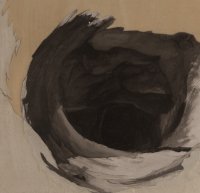Image: Simon O’Carrigan, Down To The Well, collage and ink on board, 2011.
DOWN TO THE WELL
Simon O’Carrigan
Daine Singer Gallery Melbourne
13–29 October 2011
She said it felt like a river inside her bones
When she went down to the well.*
Simon O’Carrigan’s latest ink series takes us down to the symbolic well, the gateway between worlds. In the lexicon of late capitalism, ‘well-being’ refers to quality of life and more directly to the ultimate goal of modern individualism: that transient feeling we call happiness. It is, ironically, the one thing that the economic world cannot trade, despite the best attempts to maintain the illusion through the materialist possession. Seeking the source of both the emotional and financial opposites of this position, that of depression, O’Carrigan takes us to the borders of the earth’s surface, to the edge of hidden realms, to the lips of darkness. His inky transitions slide from the browns of a familiar earth to the blacks of creeping shadows, and combine to represent the start of a journey, from surface to underworld, conscious to unconscious, present to past.
With this idea of well being, so similar to get well messages we send to loved ones who are unwell, we see the term comes to us from quite a literal place, one that is less a state of mind and more a place of spirit, an opening into our ancient, and mostly forgotten, past (ii). Cultures around the world identified with wells, ranking them as places of worship, places of fear, of renewal and new life, and they appear repeatedly in sacred texts and mythology. One example is the clootie well that is usually marked by a tree, becoming a place for the ancient votive practice of praying to a spirit – a well being – for healing. The practice of drinking, washing, even marking a significant well, operates as a symbolic ritual of the source of life.
Despite the best attempts of modern religions to convert these ‘pagan’ water spirits into more acceptable saints, installing crucifixes or statues over them and renaming them ‘holy wells’, the clooties continue to this day – in Ireland alone there are more than 3,000 (iii). The exorcism of these practices from urban life can be seen in the way that cities no longer rely on local wells tapped from the earth; our western wells are now owned by transnational corporations. Where we once brought our life source from the deep springs of dark and ancient underground water (subconscious) directly to the surface (conscious), we now construct massive damns to hold back the surface water, drowning the underworld in our excessive daily needs.
It is perhaps incongruous that the well, as a place and an object of observation, should take us from the realm of this spiritual biologic into the realm of the rational technologic. One of the great discoveries of early science, marking the beginning of the modern shift away from belief in the supernatural to a belief in the purely rational, happened inside a well. Around 200 BC, Eratosthenes of Cyrene visited the famously deep well in Syene, what is now Aswan in Egypt, and noticed that at midday on the longest day of the year, the sunlight was directly overhead and its reflection could be seen in the very centre of the well. From that day forth, the shadows began to slide up the walls of the well until they circled around to return a year later to the centre once again. From these observations, Eratosthenes correctly theorised that the world was in fact a sphere.
The well as a cultural symbol has been regarded throughout history through its signification as a source of life, a centre for communal activity. In religious texts, the well operated as a metaphor for beginnings, for accessing deeper truths and for replenishing the psyche (iv). What was once deeply interconnected and ritualised through nature is now purely constructed, surface-based, utilitarian and on-tap in a corporate-owned, user-pays system. Apposite is a growing sense of mental un-well-ness in people around the world. The ways we have physically reconstructed the earth since the days when we relied on wells, both for inner and outer connections, can be seen in parallel through our total disengagement of the psyche from our environment.
The absence of this tangible well in modern urbanity is a perhaps result of our inability to manifest the physical ritual and symbolic metaphor. O’Carrigan’s varied techniques in this series reveal these things to us, from brushstrokes in lucid swirls, to dreamlike landscapes and contemplative views down into ancient stone wells, the colours drain away, absorbed from the world by the beckoning darkness of the past.
Notes
*Down to The Well, performed by Pixies, lyrics by Black Francis (Charles Michael Thompson), 4AD Records, 1990.
ii. Rhys, J 1901, The Folklore of the Wells in Celtic Folklore in Welsh and Manx, sourced and viewed 15 September 2011, <http://www.sacred-texts.com/neu/cfwm/cf200.htm>
iii. Duckwork J 2001, Rags to Ditches: Mysterious Celtic Clootie Wells in Urban Ghosts: Forgotten Places and Urban Curiosties, viewed 10 September 2011, <http://www.urbanghostsmedia.com/2011/03/rags-ditches-mysterious-celtic-clootie-wells/>.
iv. The Bible's Deeper Meaning in Theistic Science, viewed 14 September 2011, <http://www.theisticscience.org/religion/bible.html>.
